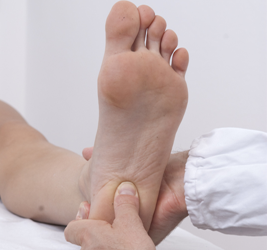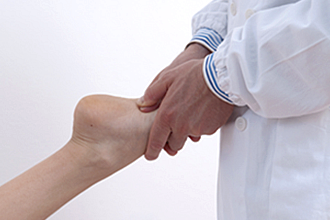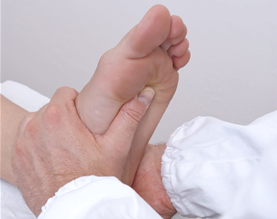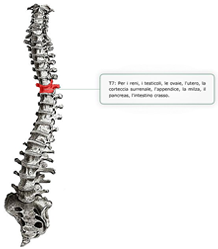Chiropractic and Plantar Fasciitis

Plantar fasciitis is a painful inflammation of the thick fibrous band of connective tissue which runs across the bottom of the foot.
Clinical Signs and Symptoms
Plantar fasciitis usually manifests as pain at the bottom of the foot (especially the medial plantar surface of the heel) that is worse with the very first steps in the morning. Pain is also accentuated with bending the foot and flexing the ankle (toes toward shins). This pain usually passes after walking, but may return after long periods of standing or rising from a seated position. There may also be lower leg and / or knee pain.
Causes
| Overuse, running | |
| Collapse of the plantar arch – pes planus (flat foot) | |
| Collapse (over pronation) that occurs with pes cavus | |
| Ill-fitting shoes | |
| Ill fitting orthotics (foot supports) | |
| Leg length inequality | |
| Adrenal stress | |
| Weak support of muscles supporting the foot | |
| Congenital deformities of the foot | |
| Knee, foot or ankle subluxations |
Chiropractic / Applied Kinesiology Approach to Plantar Fasciitis

X-rays, diagnostic ultrasound, and MRI, are usually not necessary for diagnosis of plantar fasciitis because it is a condition that can be readily understood with a thorough physical examination. Heel spurs, bunions, and other osseous changes are not defects per se, rather they represent the body’s innate, protective mechanism. Heel spurs grow in to shorten the length of plantar fascia and keep it from being overstretched and torn. Bunions create balance and stability for a foot with a collapsed arch. Surgery to remove bunions and heel spurs should be avoided.

Orthotics, or foot supports are occasionally indicated; however, they usually represent a failed attempt at rehabilitation. Moreover, if the supplier does not use manual muscle testing, the fit will be based on foot imprints which tell little about the body's neurological acceptance of the support. Orthotics must be administered only with caution and only after true rehabilitation has been attempted.
Dr. Morrison rehabilitates the foot arch with a conservative approach using manual therapies directed at the connective tissue sustaining the foot and ankle. This may involve deep, penetrating massage, and highly specific manipulation to the bones of the foot, ankle, lower leg and knee. Patients are also assessed for nutritional deficiencies, and supplements may be indicated for ligamentous support and for reducing inflammation in the foot and ankle.
Back | Schedule an appointment
 SCHEDULE AN APPOINTMENT
SCHEDULE AN APPOINTMENT








